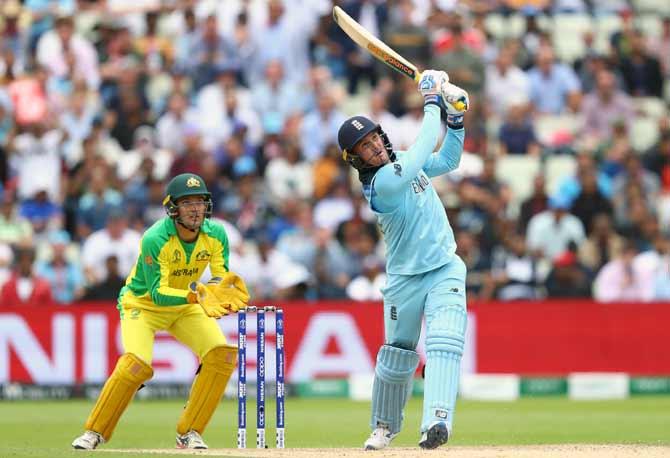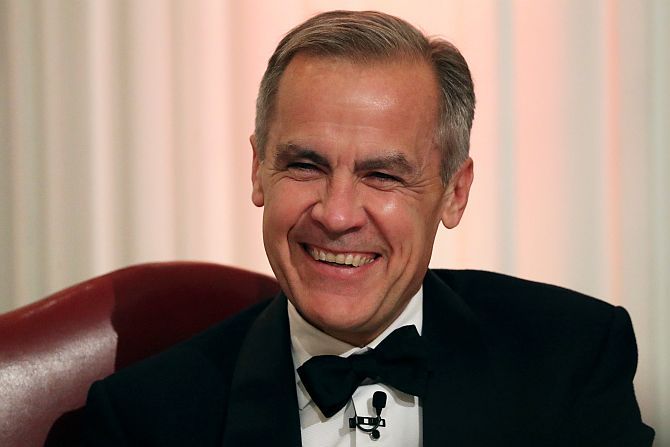 | « Back to article | Print this article |
'These are interesting days for watchers of English cricket and central banking,' points out Amol Agrawal.

One cannot escape the recent performance of the English cricket team in one-day internationals.
After pioneering the game, the focus of the English has been mostly on Test cricket, particularly the Ashes.
But they are beginning to take an interest in the shorter form of the game too.
Since playing the first ODI in 1971, England have played 737 of this variety of the game, won 371, and lost 331, with a win-loss (W/L) ratio of 1.12.
Analysts say England's performance was reasonable till the 1992 World Cup.
They reached the final three times (1979, 1987, and 1992) in the five World Cups till then.
This is reflected in the results as the W/L ratio in 1971-1992 was 1.22 (203 matches) and then declined to 0.93 (457 matches) at the time of the 2015 World Cup.
It was their early exit in the 2015 World Cup which forced the authorities to act.
They completely changed the team, and infused specialists and fresh blood.
Above all, they asked the cricketers to play fearless cricket and developed a team spirit.
In 2016-2019, we see a spectacular turnaround with a W/L ratio of 3, leading to their rise to number one rank in ODIs.
Eoin Morgan has been captain since 2011 and instrumental in bringing about the change.

The real impetus came from the batsmen.
Just like Sri Lanka batsmen of yore, the English batsmen have blazed their way to breaking not just old records but their own too.
The runs per over have improved from 4.97 to 6.34, leading the team to hold the record of the most consecutive 300-plus scores.
They also hold the record for the highest team score (481) and most analysts believe they will break the barrier of 500.
In the World Cup match against Afghanistan, they hit 25 sixes, breaking their own record of 24.
In the same match, Morgan scored 17 sixes, which is another record.
Compare this to former English captain Alistair Cook, who scored 10 sixes in his entire ODI career!

Apart from English cricket, there is another English institution that is trying to reclaim its lost status.
This is the Bank of England.
Sweden's Riksbank, born in 1668, may have been the first central bank, but it is the Bank of England that shaped central banks and their practices the world over.
However, the Bank of England lost the race, first to the Federal Reserve as the US replaced the UK as the biggest economy of the world in the early 20th century.
Then it was nationalised in 1946 and became an arm of the British government.
It faced criticism for high inflation in the 1970s and the currency crisis of 1992 (the year English cricket's decline began).
Most monetary policy innovations happened in central banks such as those in New Zealand (inflation targeting), Sweden (transparency, communications and now digital money), and so on.
In 1998, the Bank of England began resuscitating itself.
It got independence from the government, started inflation targeting, and allowed the pound to float, leading to lower inflation and an end to currency speculation.
But it was seen more as a follower as other central banks had introduced these practices.
The Bank of England got an opportunity to again be a leader during the 2008 crisis.
The crisis posed questions to the central bank on price stability and ignoring financial stability.
The Bank of England itself was guilty because it could not save Northern Rock despite pioneering the central bank function of being the lender of the last resort.

Just like Cricket England, the Bank of England converted the crisis into an opportunity.
Led by Mark Carney, it has made pioneering, large-scale changes.
Carney is Canadian and Morgan Irish (to drive home how outside talent is driving change).
The central bank has instituted the financial policy committee, which takes care of macro-prudential risks, and houses the prudential regulatory authority, which looks at micro or supervision risks.
This ensures the central bank looks at both, price and financial stability, with different offices being accountable for different risks.
It has also innovated.
In particular, the Bank of England, along with its New Zealand counterpart, has led efforts to simplify central bank communication, using cartoons and pictures.
The Bank of England is playing the central role in the world of climate finance and digital payments.
A recent bank report on the future of finance suggests the central bank should be a world leader in digital regulation.
In a recent speech, Mr Carney said his organisation would approach Facebook's currency, Libra, 'with an open mind, but not an open door' and study the project to transform payments in the country.
This is very different from other central bankers and monetary thinkers, who have rejected the idea outright.
The Old Lady of Threadneedle Street, as the Bank of England is called, is trying to remain young at heart and spunky in action!
These are interesting days for watchers of English cricket and central banking.
Both were in the woods, but seem to have found Robert Frost's lines scribbled somewhere there: 'The woods are lovely, dark, and deep but I have promises to keep and miles to go before I sleep.'